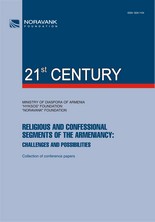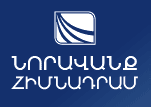 11.04.2012
11.04.2012
"21st CENTURY", N 1, 2012
Լույս են տեսել «Նորավանք» ԳԿՀ «21-րդ ԴԱՐ» N 2(42), «21-й ВЕК» N 2(22) և «21st CENTURY» N 1(11) ամսագրերի հատուկ թողարկումները, որոնցում տեղ են գտել 2011թ. դեկտեմբերի 9-10-ը ՀՀ Սփյուռքի նախարարության, «Հիքսոս» հիմնադրամի և «Նորավանք» ԳԿՀ-ի կողմից կազմակերպված միջազգային գիտագործնական կոնֆերանսում կարդացված զեկուցումները։ Համարներն ունեն «Հայության կրոնադավանական հատվածներ. մարտահրավերներ և հնարավորություններ» ընդհանուր անվանումը և նվիրված են հայության կրոնադավանանքային խնդիրներին, այլակրոն և այլադավան հատվածներին, Թուրքիայի իսլամացված հայերին, կրոնափոխ համշենահայերին և նրանց ինքնության զարթոնքին։
Ստորև ներկայացնում ենք հոդվածների համառոտագրերը անգլերեն։
Գագիկ Հարությունյան
ՀԱՅՈՒԹՅԱՆ ԿՐՈՆԱԴԱՎԱՆԱՆՔԱՅԻՆ ԽՆԴԻՐՆԵՐԸ ԳԼՈԲԱԼ ԶԱՐԳԱՑՈՒՄՆԵՐԻ ՀԱՄԱՏԵՔՍՏՈՒՄ
|
Համառոտագիր
|
| A considerable part of ethnic Armenians, at least 10% by various estimates, are not adherents of the Armenian Apostolic Church. In addition to the Armenian Catholics, Evangelicals and Orthodox, there is a sizeable mass of Islamized Armenians. Obviously, forming expert opinions on Armenians of different confessions and religions is not only an issue of self-knowledge, but also an urgent task for spiritual security (SS), which is an important component of the national security (NS). Undoubtedly, without having clear ideas about the different confessional and religious segments it would be impossible to develop mechanisms for consolidated and effective activities by the Armenian public. At the same time it is known that in principle, no isolated areas can exist in the NS system, and even the problems of totally different nature are interconnected to a greater or lesser extent. |
Վարդան Ասցատրյան
ՀԱՅՈՒԹՅԱՆ ԱՅԼԱԿՐՈՆ ԵՎ ԱՅԼԱԴԱՎԱՆ ՀԱՏՎԱԾՆԵՐԻ ՀԱՐԱԲԵՐՈՒԹՅՈՒՆՆԵՐՆ ՈՒ ՄԻԱՎՈՐՄԱՆ ԽՆԴԻՐՆԵՐԸ
|
Համառոտագիր
|
| In the current transitional period of the multi-polar world civilizational conflicts take place, with the globalized world being formed in parallel. These processes imply spiritual and cultural collisions and possible expansions. Only the nations that act in a coordinated manner are capable of scoring victories or at least gaining advantageous positions. Meanwhile, nations unable to determine their course, or follow a wait-and-see policy, eventually fall under the influence of the others. In this context it is a crucial issue whether in present conditions a given nation has a clearly formed civilizational concept and competitive capacities to implement it. |
Հովհաննես Հովհաննիսյան
ՀԱՅՈՒԹՅԱՆ ԺԱՄԱՆԱԿԱԿԻՑ ԽՆԴԻՐՆԵՐԸ ԿՐՈՆԱԿԱՆ ՀԱՐԹՈՒԹՅԱՆ ՄԵՋ
|
Համառոտագիր
|
| Over the history of the Armenian people, along with the political and staterelated issues the religious, ecclesial and theological ones were among the most discussed and analyzed problems. Already in the 5th century the “Ecumenical” Council of Chalcedon led to division between Chalcedonian and non-Chalcedonian churches, setting conditions for further course of not only ecclesial/religious, but also the political life. Later the numerous other ecclesial splits not only deepened the ecclesiastical or religious/confessional differences alone, but also shaped the processes of identity formation and differentiation for various nations and ethnic groups. Naturally the Armenian Church and Armenian people could not stay away from these processes. The Great Schism of 1054, and later also the church division during the Reformation period directly affected the Armenian reality. |
Արեստակես Սիմավորյան, Վահրամ Հովյան
ՀԱՅՈՒԹՅԱՆ ԴԱՎԱՆԱՆՔԱՅԻՆ ՀԱՏՎԱԾՆԵՐԻ ՀԱՄԱԽՄԲՄԱՆ (ՀԱՄԱԳՈՐԾԱԿՑՈՒԹՅԱՆ) ՁԵՎԵՐԸ ԵՎ ՄԵԽԱՆԻԶՄՆԵՐԸ
|
Համառոտագիր
|
| One of the main objectives for studying the confessional strata of the Armeniancy is to develop effective mechanisms for consolidation of the national potential. This is a particularly urgent matter for Diaspora, as facing its challenges implies combination of all-national efforts. Hence, creating an environment of effective cooperation between Armenian Apostolic, Catholic and Evangelical Armenian communities abroad is an imperative for survival and development of these communities. The problem of finding pathways to inter-confessional solidarity in Diaspora has both theoretical and practical dimensions. Therefore, consolidation of the national potential implies unification of different confessional segments of the Armeniancy, as well as development and implementation of effective theoretical and practical means for bringing them to a single unified national ground. There are two aspects in this problem. |
Յակոբ Չոլաքեան
ԾԱԳՈՒՄՈՎ ՀԱՅ ԼԱՏԻՆՆԵՐԸ ՍՈՒՐԻՈՅ ՄԷՋ
|
Համառոտագիր
|
| The article discusses the Latin Catholic proselytism that took place starting the late 19th century in northwestern regions of Syria with dense Armenian population, the conditions and methods of spreading the Latin rite Roman Catholic faith, the composition of Latin communities of Armenian descent, as well as the existence of numerous Armenian families that comprise separate churches or are scattered among the non-Armenian Latin rite Roman Catholic communities. The essence of Latin Church and its approach to the national values are touched upon; thereafter efforts to bring the Latin rite Roman Catholics back to the Armenian Church, as well as the current situation of the remaining Latins are presented. An attempt is made to present in this article all of the above-mentioned topics against the backdrop of the general situation related to foreign religious movements and the Armenian Church. |
Ռուբեն Մելքոնյան
ԹՈՒՐՔԻԱՅԻ ԻՍԼԱՄԱՑՎԱԾ ՀԱՅԵՐԻ ԹԵՄԱՅԻ ՈՒՍՈՒՄՆԱՍԻՐՈՒԹՅՈՒՆԸ. ԽՆԴԻՐՆԵՐ ԵՎ ՀԵՌԱՆԿԱՐՆԵՐ
|
Համառոտագիր
|
| In the Armenian reality the issue of the forcibly Islamized Armenians has drawn the attention of the experts and general public in different periods. Valuable publications, accounts, travel notes, articles can be found since the 18th century with regard to the different groups of Armenians who have been estranged from their roots under the pressure of Islam. In this relation it is worth to mention such authors as Hakobos Tashian, Minas Bzhshkian, Atrpet, Hovakim Hovakimian, Sarkis Haykouni, Grigor Artsruni, Vladimir Gordlevski and others who had done much work in this direction. In the Soviet period Levon Khachikyan, a prominent scholar, wrote a remarkable article about the Islamized Hamsheni Armenians, whereas Barunak Torlakyan, a Hamsheni Armenian himself, published interesting materials on the ethnography and history of the Hamsheni Armenians’ Christian and Muslim segments. |
Սերգեյ Վարդանյան
ԿՐՈՆԱՓՈԽ ՀԱՄՇԵՆԱՀԱՅԵՐ. ՓՈԽԱԴԱՐՁ ԾԱՆՈԹՈՒԹՅՈՒՆ
|
Համառոտագիր
|
| Today, at the end of 2011, when just several months are left before celebrations start for the 500th anniversary of the Armenian book printing, when hundreds of newspapers and magazines are published in Armenia and all over the world in Armenian language, it is hard to believe that we, Armenians, a nation with 1600 years old writing and literature do not fully know ourselves. Even 130 years ago the Meghu Hayastani newspaper published in Tiflis staged a discussion whether Protestant or Catholic Armenians could be considered Armenians or not. In 1880 the celebrated writer Raffi wrote in “Mshak” (#121): “Neither Catholicism, nor Protestantism, nor even Islam cause the Armenian to cease being an Armenian”. However, the words of the great writer did not become an accepted view; such disputes and controversies in Armenia and Diaspora have ruined many lives and even resulted in bloodshed. Today, perhaps many will answer with a smile that both Catholic and Protestant Armenians are certainly Armenians as well, but there are also those in the words or attitudes of whom some sort of reservation is felt. |
Համօ Մոսկոֆեան
ԿՐՕՆԱՓՈԽ ՀԱՅԵՐՈՒ ԶԱՐԹՕՆՔԸ
Հետազօտող լրագրողի վկայութիւններ
1980-2011թթ.
|
Համառոտագիր
|
| In September 1980, when a military coup d'état took place in Turkey led by Kenan Evren, head of a fascist junta, thousands of progressive and left-wing activists fled to Syria and Lebanon to escape mass arrests and hanging. Some of them, being skillful revolutionaries and professional combatants, joined the ranks of the Palestinian revolutionary organizations. As a reporter, I built close relations with Devrimci Sol (Revolutionary Left), Devrimci Yol (Revolutionary Path), Partizan Yol (Guerilla Path), Türkiye Komünist Partisi Lenincileri (Communist Party of Turkey – Leninists), THKP Acilciler and- TİKKO-Türkiye İşçi Köylü Komünist Partisi (Popular Party of Turkey and Workers and Peasants Communist Party of Turkey), P.K.K. (Kurdistan Workers' Party) and some other organizations, many members of which were converted, Kurdified and Turkified Armenians. Also their ranks later included people that struggled for recognition of the Armenian Genocide, such as Taner Akçam, Hrant Dink, Mihraç Ural, Abdullah Ocalan (“Apo”), Erkin Erkiner, Aram Tigran and many others. |
Բաժանորդագրությունը` www.pressinfo.am, Հայմամուլ
Online վաճառքը՝ www.pressinfo.am
Գնումը`«Նորավանք» ԳԿՀ-ում
Հասցեն՝ ք.Երևան, Գարեգին Նժդեհի 23/1,
Հեռ. +374 10 44 04 73, +374 93 54 31 71
 11.04.2012
11.04.2012


